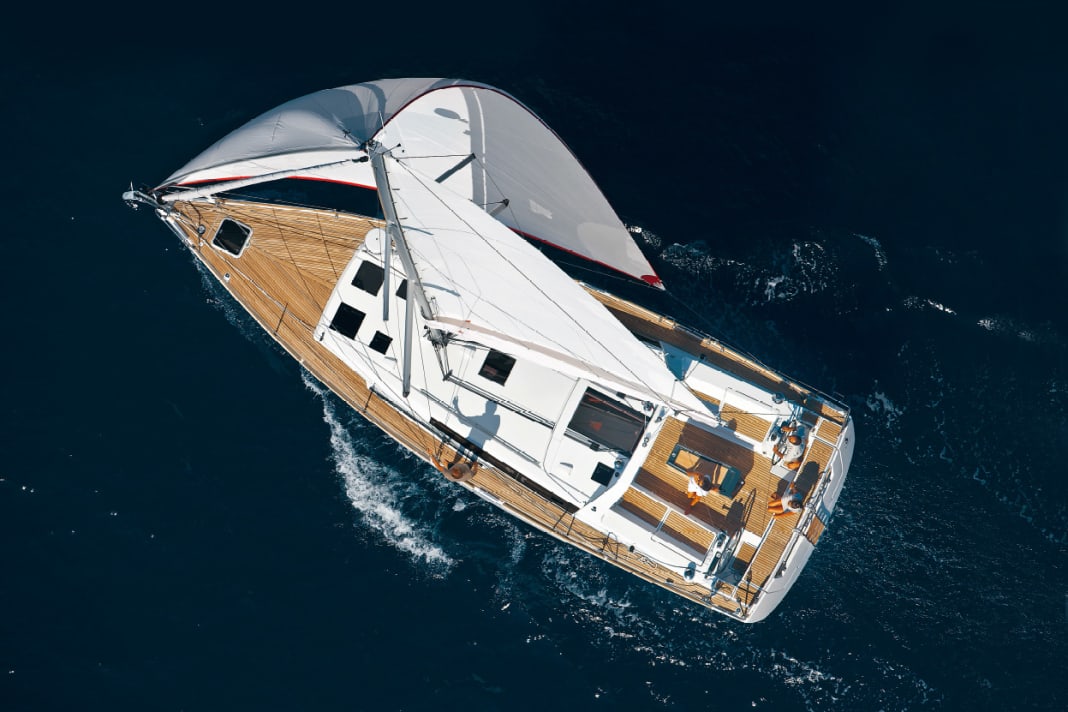





- Optimisations from free to expensive
- Antifouling
- Countersunk bow thruster
- Folding propeller
- Culverts
- Keel and rudder profiling
- Filling gaps
- Clean out the baking box
- Embankment
- Correct bunkering
- Sorting tools
- Adjust hole points
- Low-stretch traps
- Wind threads
- Membrane sails
- Softrigging
- Markings
- Carbon fibre rig
- Backstay tensioner
- Draw polar diagram
- Adjusting instruments
- Place adverts correctly
- Wednesday regattas
- Others observe
- Skipper training: learning with the pros
- Further training: Weather, tactics and more
Comfort - hardly any other term can be interpreted so differently. Many shipyards and cruising yachtsmen now understand it to mean a generous amount of space. On closer inspection, however, aspects such as sea behaviour, operability and sailing performance of the yacht also play an important role.
The good thing is that while the amount of space is usually a fixed factor, the sailing characteristics can be optimised at a later date, and not just for racing yachts. Regardless of the boat concept, there is almost always room for improvement. This may be because the shipyards have dispensed with cost-intensive steps such as the careful profiling of the keel and rudder from the outset and have saved on fittings, or because the yacht is getting on in years and has put on fat, i.e. excess weight.
This may be additional equipment such as radar antennas and the retrofitted bow thruster, or it may simply be that more and more equipment has accumulated in the stowage spaces. Then there is the ageing sail wardrobe and countless layers of antifouling that may be peeling off, increasing frictional resistance.
Optimisations from free to expensive
However, there are no comparisons for new boats, and the performance of older yachts declines gradually, so that deficits are often not even noticed. The realisation that "you have the better sails" is often used as an excuse when your neighbour at the jetty is pulling away at the cross. However, cruising sailors often find it difficult to take the step of actively optimising the boat. Individually, the effects seem too small to be worth the work and investment. In total, however, the performance of the yacht changes considerably.
We spoke to designers, sailmakers, boat and rig builders to find out how sailing performance and therefore sailing comfort can be optimised. Every yacht only works as well as its crew. Training is therefore one of the most efficient measures. And while there are tuning measures that can easily cost tens of thousands of euros, other optimisations are free and can be completed in a single afternoon!
Antifouling
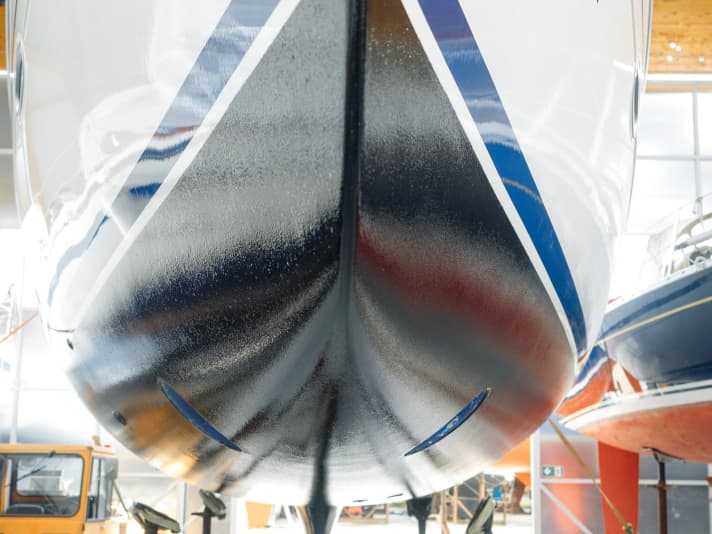
The surface quality of the underwater hull has a major influence on the frictional resistance of the boat. Professor Kai Graf from the Yacht Research Unit in Kiel explains the connection: "The proportion of frictional resistance in the overall resistance varies between 20 and 80 per cent depending on the type of boat and speed. It is high at very low speeds, rather low at medium speeds, and then increases again. It is therefore always worth reducing friction." The aim is to achieve a hydraulically smooth surface. This means that the individual irregularities must not protrude from the so-called viscous sub-layer that always forms.
The thickness of this layer and thus the permissible roughness depends on the size of the ship and the speed, and locally even on the distance to the stem. In practice, this means that the foreship of a yacht hull must be smoother than the stern, or keels and rudders in the forward area must be smoother than further aft. "My personal experience is that you can achieve a hydraulically smooth underwater hull by wet sanding with 200 to 600 grit and spraying on a well-levelling thin-layer hard antifouling," Graf continues. Another option is to use epoxy systems containing copper, such as Coppershield. They can also be sanded in such a way that a hydraulically smooth surface is achieved.
- Effect: clear advantages, especially in light winds
- Costs: from 400 euros per square metre
Countersunk bow thruster
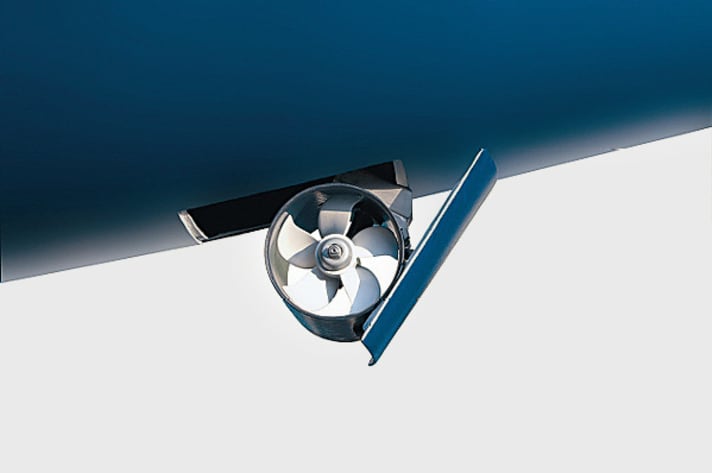
Disturbances in the foredeck area influence the flow pattern along the entire hull, which is why an open bow thruster is considered an extreme performance killer. Spaced spoilers at the front and moulded trailing edges can reduce the resistance of the tunnel. However, only retractable models are really good. They are about three times as expensive, heavier and only available for yachts over 40 feet.
- Effect: almost as good as a smooth hull
- Costs: about 7,000 euros
Folding propeller
The streamlined propeller is clearly noticeable. In a practical test with two identical Sun Odyssey 39i boats, the folding prop boat sailed almost half a knot faster than the yacht with a fixed three-blade propeller. Depending on the concept, the prop also saves fuel and stops better.
- Effect: up to half a knot
- Costs: approx. 800 to 3,000 euros
Culverts
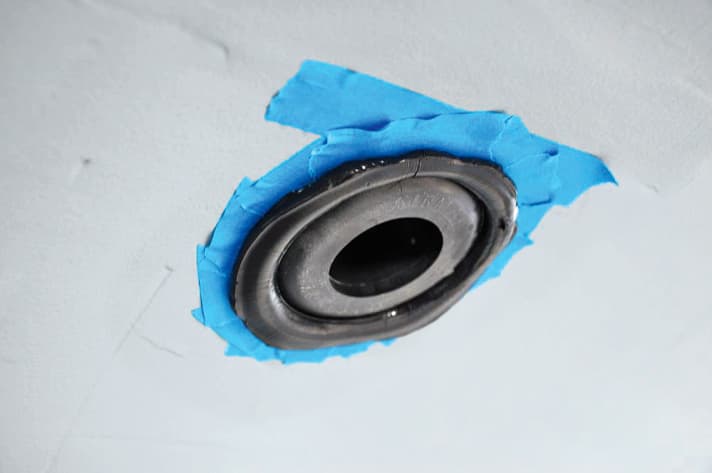
"For cruising yachts, the choice of through-hull openings is irrelevant," says designer Marc-Oliver von Ahlen. Theoretically, every opening in the hull generates braking vortices. This means that flush-mounted or, even better, hollowed-out or closable through-hull openings at the trailing edge should be an advantage. In practice, the effect is so small that there are far more effective tuning measures.
- Effect: Barely measurable
- Costs: about 220 Euro per diffuser
Keel and rudder profiling
"A well-intentioned improvement by eye doesn't achieve anything apart from work and sanding dust," says designer Marc-Oliver von Ahlen - but reworking to a profile that suits the boat does. Hydrodynamics expert Professor Kai Graf from the Yacht Research Unit in Kiel particularly emphasises the so-called laminar profiles, which can save up to 30 percent of the frictional resistance. Unfortunately, these profiles only work well at small angles of attack, above which the resistance is even greater than with conventional profiles. Because the maximum lift is also reduced, they are hardly suitable for rudder blades. When choosing the right profile, it is best to seek expert advice. Graf recommends the students at Kiel University of Applied Sciences: "Our students like to earn an extra income by making appropriate profile templates." The front 30 per cent of the airfoil length is particularly important so that the flow remains laminar for a long time. A thick trailing edge is also disadvantageous. It creates a braking vortex. Von Ahlen recommends grinding it to a thickness of around three millimetres.
- Effect: Less resistance and less drift
- Costs: from 3,000 euros
Filling gaps
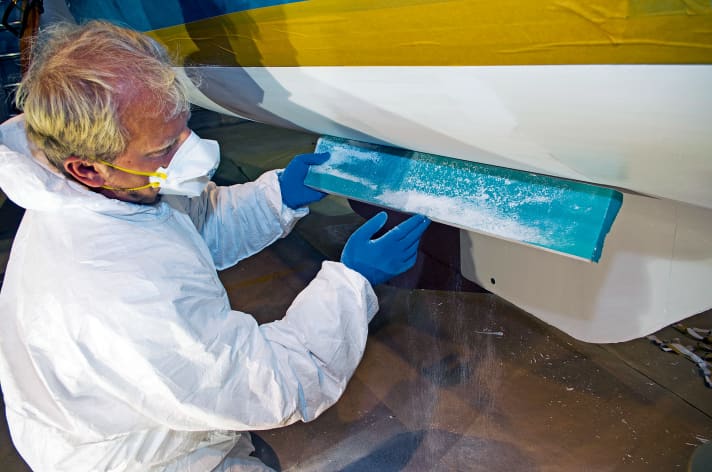
Many standard boats have a wide gap between the upper edge of the rudder blade and the hull. This should be minimised as much as possible. Marc-Oliver von Ahlen explains why: "Firstly, the so-called interference resistance, which is caused by the overlapping of the individual flows of the rudder and hull, is reduced. Secondly, the effective aspect ratio of the rudder blade is doubled if the gap could theoretically be reduced to zero. This would reduce the drag enormously and also improve the steering characteristics and upwind performance." However, the geometry often sets a limit to this optimisation, as the deflecting rudder blade comes into contact with the fuselage.
- Effect: Better control characteristics
- Costs: Time required about two hours
Clean out the baking box
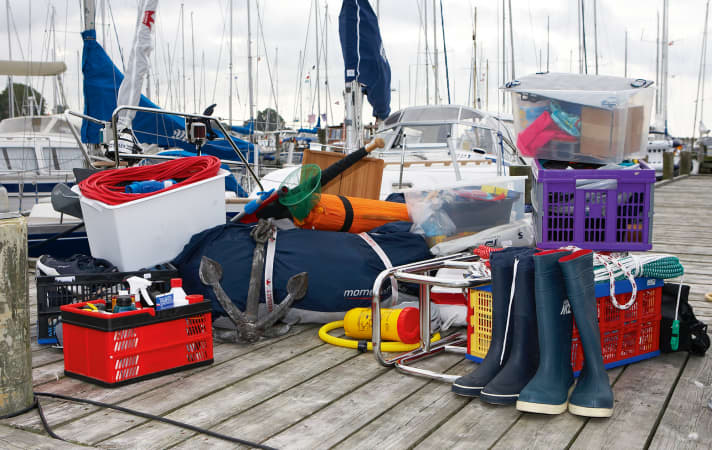
"One owner once brought a half-full pack of washing powder into the car shortly before the start of the regatta. It's pure psychology," says Marc-Oliver von Ahlen, describing the problem. "But I'm surprised when owners load their boats in spring so that the supplies last for the rest of the season," the designer continues. In order to achieve its full potential, the boat should float on the design waterline. A hull that dips deeper or is trimmed aft has an increased wetted surface and more resistance in the hull downstream. If you want to optimise here, you need discipline, because only what is absolutely necessary should be on board. Matthias Bröker from the design office Judel, Vrolijk & Co quantifies the effect using a ten-metre example yacht: "300 kilograms of additional load costs 3.5 seconds per nautical mile." That doesn't sound like much, but the effect is enormous in view of the low cost.
- Effect: Better light winch properties
- Costs: one afternoon and discipline
Embankment
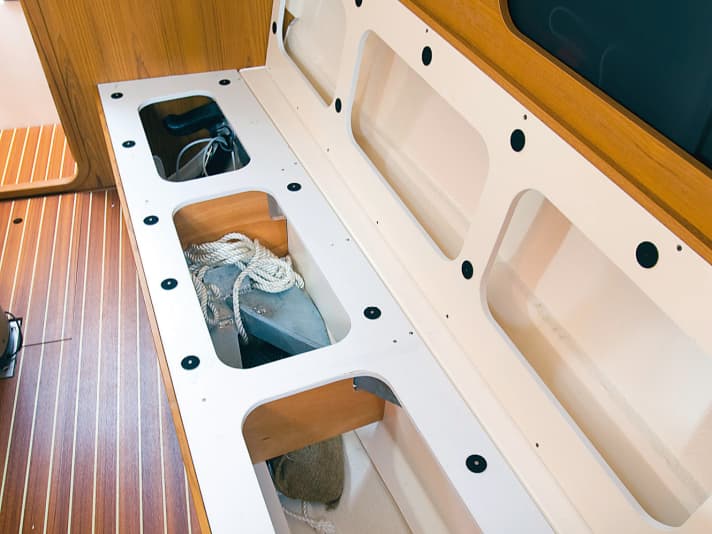
If weight is to be added, then it is best to do so in such a way that it reduces the sailing performance as little as possible. The most obvious approach is to stow everything heavy as low as possible. Heavy equipment in particular should also be stored as centrally as possible. A second anchor under the saloon bay is not particularly practical. However, compared to stowing in the anchor locker or in the forecastle, the inertia of the boat is reduced, which benefits the sea behaviour.
- Effect: Better sea behaviour
- Costs: Discipline
Correct bunkering
As owners' need for comfort has increased over the years, so has the tank capacity of yachts. Nowadays, even nine-metre boats can hold 200 litres of water and 100 litres of diesel or more. Such an additional load can be very noticeable, so the tanks should only be filled as far as necessary. The longitudinal trim of the boat should always be taken into account! On many standard yachts, the water tank in the foredeck also serves as a trim weight. This makes you lighter with an empty tank, but the increase in drag due to the stern-heavy trim eats this up again - and the boat may end up sailing even slower than before.
- Effect: see Clean out the baking box
- Costs: none
Sorting tools

If you take a selection of tools adapted to the boat and the available screws instead of universal tool sets, you will save several kilograms. The range of screwdrivers and the fork wrench can be replaced by a set of bits and an open-end spanner, for example.
- Effectsavings of up to 10 kilograms
- Costs: depending on quality 50 to 400 Euro
Adjust hole points
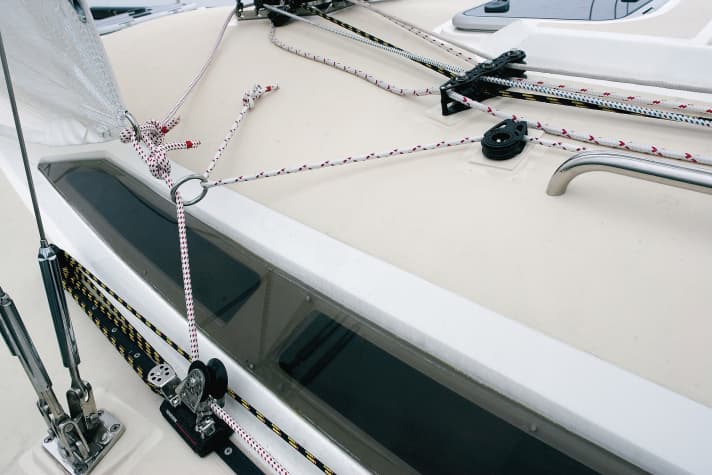
On many standard boats, the genoa rails are mounted in such a way that the sheet angle is well over ten degrees. However, with non-overlapping headsails, much smaller angles of attack are sometimes desirable. The sail can be sheeted more tightly with an inward-acting barber spar. How useful this measure is depends on the boat, the headsail and the helmsman's sailing skills: the smaller the angle of attack, the more sensitive the sail reacts to course changes. With a snatch block or a threaded ring, a barber furler can be easily retrofitted to test the effect. An outer sheet is similarly effective. When dropping, the standard hoisting point (especially with narrow headsails) is quickly too far inboard, the headsail twists, opens in the leech and releases pressure. The hoisting point must therefore be shifted forwards and outwards.
- Effect: more height and better half-wind trim
- Costs: about 50 to 250 Euro
Low-stretch traps
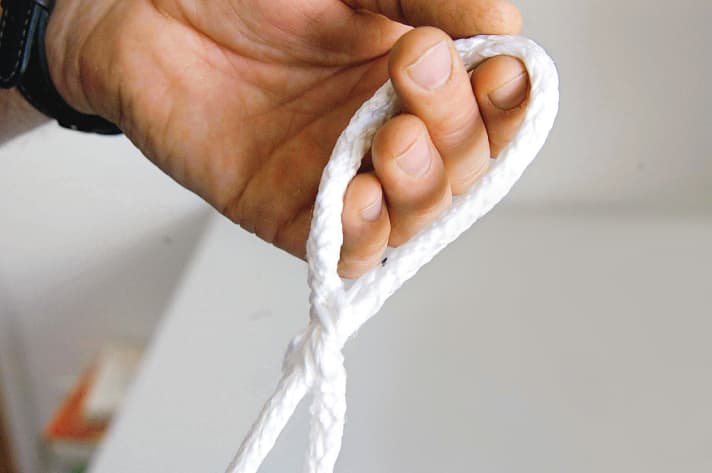
If you want to save the last gram of top weight, you can remove the cover of the halyards. This only works with Dyneema cordage, as the core carries the load and the fibre can withstand UV radiation. The weight saving is around 60 per cent. In practice, the lower stretch and the lighter run over the deflections are more noticeable.
- Effect: lighter run
- Costs: a few hours of splicing work
Wind threads
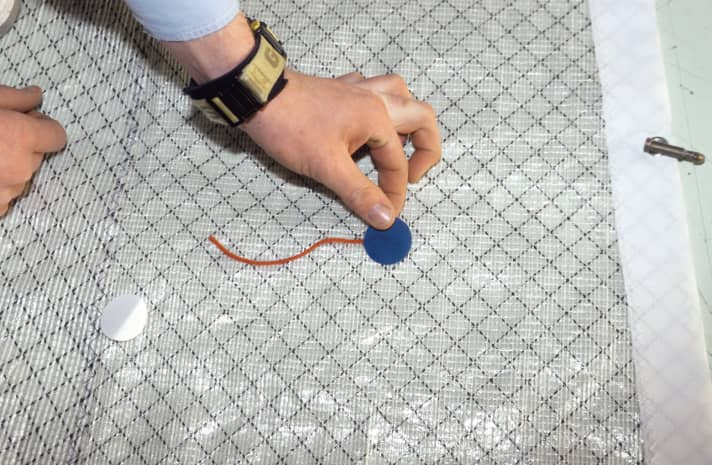
Trim tapes are the most efficient of all tuning measures and should actually be obligatory on all sailing yachts. The small woollen threads indicate extremely sensitively whether the current is on the sail or not, allowing the foresail and mainsail to be optimally adjusted. In the lower quarter of the headsail, they also serve as a steering aid high up in the wind. If the sail is also equipped with threads in the upper quarter, the twisting can be controlled at the same time. In the mainsail, leech tethers are a particularly important aid. The twist of the sail can be controlled via the upper one. If it constantly folds away behind the sail, the twist must be increased.
- Effect: Facilitate sail trim and steering
- Costs: a few euros
Membrane sails

Not the cheapest, but one of the most noticeable changes. Sails made of aramid or carbon fibre hardly stretch at all. As a result, they retain the profile designed by the sailmaker not only over their service life, but also when the wind pressure changes. In practice, this means that once a sail has been trimmed flat, it retains its good aerodynamic shape even in gusts, resulting in less heeling and more propulsion, and the boat sails more controlled overall. And due to the low stretch, trim elements such as backstay tensioners and cunningham are more effective, which further increases the sail's range of use. The positive effects are particularly noticeable on the cross, as the boat sails higher and can be held on the wind edge more easily.
Prices vary greatly depending on the manufacturer and design. Stefan Voss from UK Sails calculates the additional costs compared to a good touring sail made of Dacron at between 45 and 80 per cent, whereby the latter is the regatta version of the titanium membrane. Membrane sails also have clear advantages in terms of weight. For example, a stable Dacron for an X-332 weighs 30 kilograms, whereas a comparably robust carbon fibre membrane with a double taffeta coating weighs only 21 kilos. The regatta version of the sail comes in at 18 kilos and extremely light versions even weigh just 12 kilos, but with compromises in terms of durability.
- Effect: Stable trim over a wide wind range
- Costs: 45 to 80 per cent surcharge
Softrigging
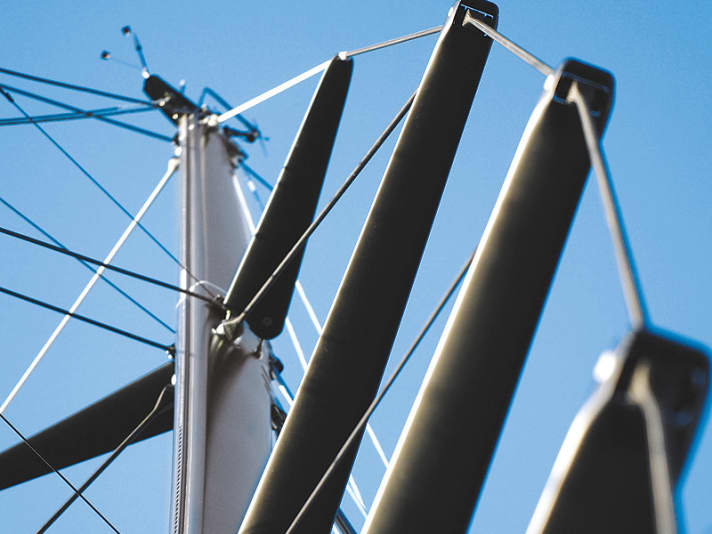
Around 15 kilograms can be saved by replacing the standing rigging of a ten-metre boat with stays made from PBO. Without changing the keel, this increases the stability of the boat and reduces the inertia of the rig. Designer Matthias Bröker quantifies the possible speed gain at around 0.7 seconds per nautical mile. This almost corresponds to the maximum advantage of a much more expensive carbon fibre mast. For cruising boats, tuning measures such as better sails are likely to have a clearly noticeable effect.
- Effect: More stability, less pitching
- Costs: around 12,000 euros for 33 feet
Markings
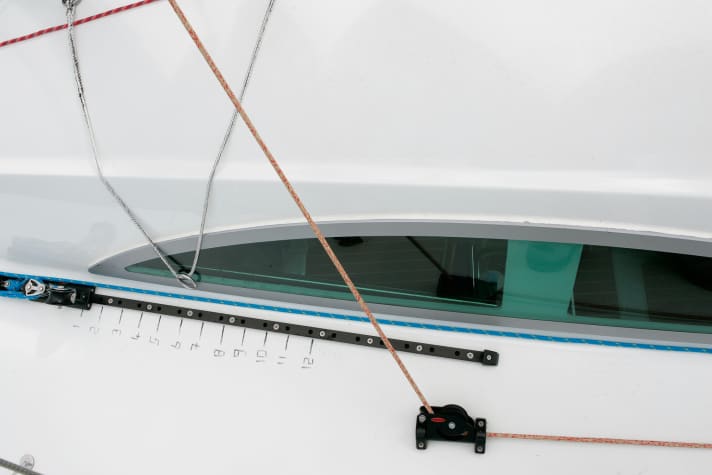
To record settings once they have been found and make them reproducible, it is important to return all trim elements to the same positions. Markings on the spreaders and trim scales on the genoa tracks help with this. The values sailed are then recorded in a table together with the weather conditions.
- Effect: Reproducible settings
- Costs: none
Carbon fibre rig
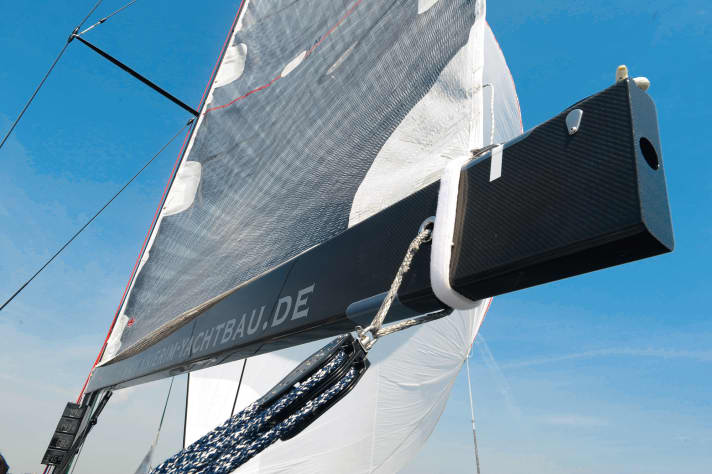
The high-strength masts are considered to be extremely light. How much weight can actually be saved depends heavily on the size of the boat, the construction method and the fibres used. Sometimes a filigree aluminium rig is hardly heavier than the carbon tube. In the case of an X-332, the advantage is just 17 kilograms or 14 per cent. Carsten Burfeind from mast builder Hahnfeld emphasises other qualities. The carbon rig is significantly more rigid, the mast pumps less and allows more forestay tension with 9/10 rigging.
- Effect: stiffer rig, weight saving
- Costs: around 18,000 to 40,000 euros
Backstay tensioner
The sag of the forestay is controlled by the tension on the backstay, which has a major influence on the maximum possible height. It also changes the mast bend, which flattens the profile of the mainsail and reduces heeling. The backstay tensioner should be able to be operated by the helmsman or mainsail trimmer. Depending on the boat size and rig type, reduction ratios of 8:1 to 24:1 are common; stronger systems are usually hydraulic.
- Effect: more height, less heeling
- Costs: approx. 200 to 2,500 euros
Draw polar diagram
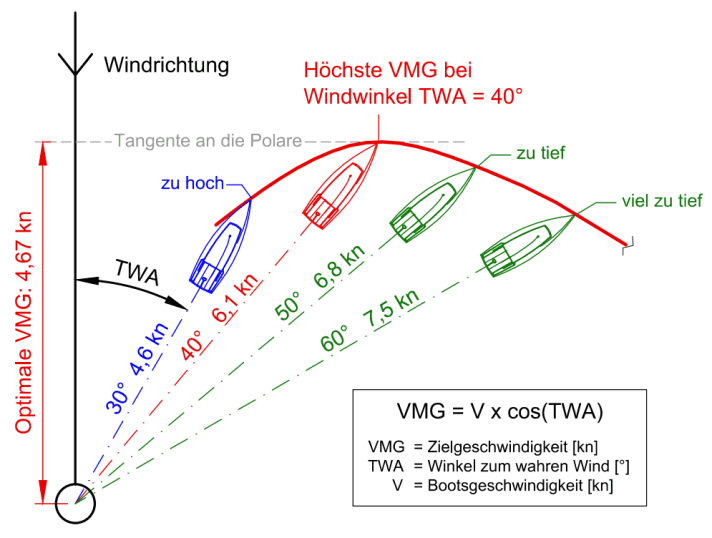
The highest possible course upwind is not the fastest way to windward. To sail the ideal cross, the maximum VMG (velocity made good) is of interest, i.e. the target speed to windward. It can be read from the yacht's polar diagram. It is therefore very practical to have this data set available. The polar diagram can be obtained by yourself, provided you have the stamina and work meticulously. To record the data, the courses must be sailed in consistent wind and wave conditions and the speeds noted. The basic requirement is a Well-adjusted instrument systembecause the polar diagram works with the true wind values. In addition, the measurement runs must be repeated in different wind conditions, as the optimum height changes with the wind strength.
The work can be made easier with PC programmes and apps, but there are still many sources of error. Another way is to measure the yacht. If you have an ORC measurement report created, you will automatically receive the boat polars calculated with the help of a so-called VPP (Velocity Prediction Programme). These speed values can be used as target boat speeds. On the one hand, to improve the trim, but they can also be used as a steering aid. For example, the optimum VMG is 4.67 knots. The helmsman can now try to achieve this value by luffing and dropping. If the boat is optimally trimmed, it will automatically sail the ideal course. Of course, this also works downwind.
- Effect: Determining the optimum courses
- Costs: Measurement around 1,000 euros - or considerable time expenditure
Adjusting instruments
Only when the log, compass and Windex provide values that are as accurate as possible can the instruments be used sensibly as a trimming aid. This is because individual measurement errors continue. Starting from an incorrect speed through the water, the system calculates an incorrect height in relation to the true wind, and therefore incorrect tacking angles and the wrong geographical wind direction.
- Effect: reliable Trim data
- Costs: half a day
Place adverts correctly
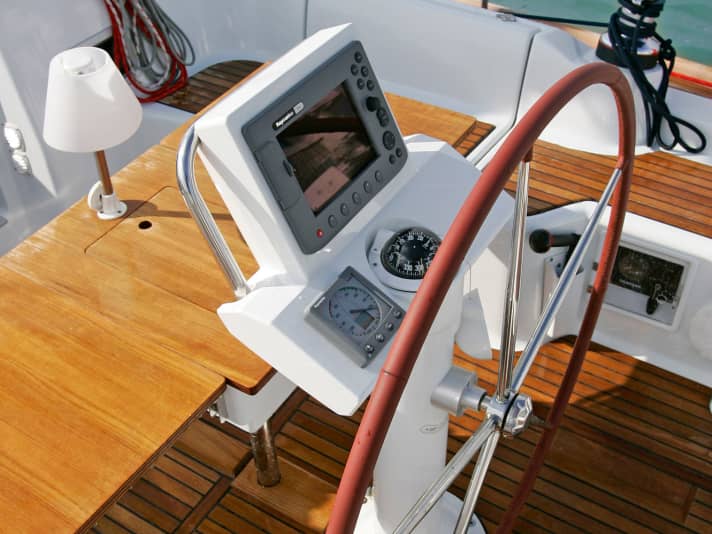
On most yachts with wheel steering, the plotter sits directly on the steering column - a very bad position for trimming, as this gives the skipper a monopoly on information. And even he can only see the display when he looks down; sailing according to target or boat speed is hardly possible. Data such as VMG, boat speed and true wind angle should also be visible to the crew. The easiest way to achieve this is with additional maxi displays on the mast. Depending on the manufacturer, you can expect to pay around 900 to 1,200 euros per display and bracket. Sounds expensive, but it's cheaper than installing several small displays so that they can always be seen from upwind. Especially as the current Maxis can usually display three to four values simultaneously and in a usable size.
- Effect: Data visible for skipper and trimmer
- Costs: for NMEA 2000 systems around 900-1,200 euros
Wednesday regattas
Short but often quite ambitious club regattas are held in various sailing areas in the middle of the week. Apart from the undisputed fun of social club life, racing around the buoys helps to hone personal skills. The colourful cloth is rarely used on holiday as often as the spinnaker is set in an event. If you don't have a boat: Crew are almost always needed!
- Effect: Fun and practice at the same time
- Costs: approx. ten euros entry fee
Others observe
Sounds banal, but it's not: anyone travelling with a boat of an unknown size or type, or even entering a new standard class, would do well not to sail only against comparable yachts. It is just as helpful to observe the other crews at work. How do they steer, trim and manoeuvre their boat, what tricks do they use, how are the deck layouts modified?
- Effect: Steep learning curve
- Costs: none(!)
Skipper training: learning with the pros
Practical training in small groups is an efficient way to improve your sailing skills. Professionals like kite ace Markus Wieser (spi-markus-wieser.de), ocean sailor Tim Kröger (timkroegeryachting.com) or single-handed specialist Jan Hamester offer various topics for small groups with equipment provided or even individual coaching and tuning on your own boat. Kröger's skipper training, for example, lasts three days and is organised for a maximum of ten people on two yachts. The course content: Manoeuvres, trim, regatta rules and safety.
- Effect: individually very different
- Costs: from 1,000 euros/three days
Further training: Weather, tactics and more
In order to become better and safer in the complex subject of sailing, there are also seminars on theoretical topics such as meteorology, regatta rules, tactics, trim and boat tuning or engine technology in addition to the practical training programmes. Providers include various sailing schools as well as the large Hansa Ocean Sports Association (DHH). Sailing clubs are also increasingly organising training and lecture events to promote club life. The events are usually also open to non-members. They are also a good opportunity to get to know a club better.
- Effect: Everything possible from low to high
- Costs: free of charge up to around 200 euros

